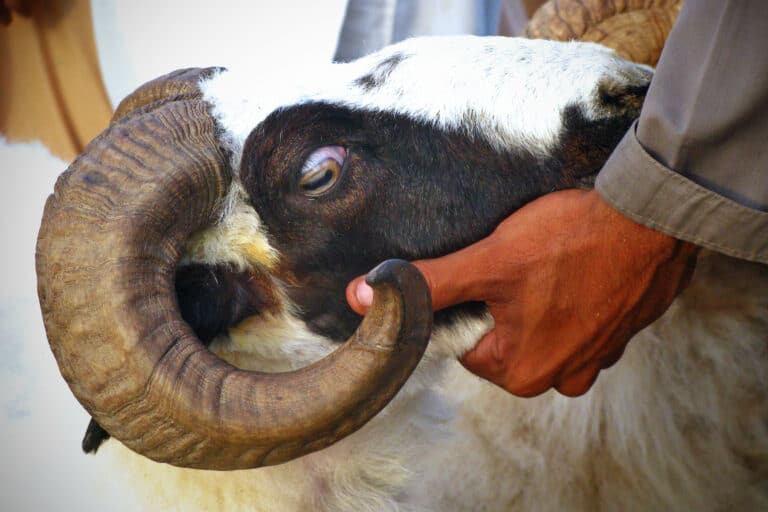The Muslim holiday of Eid al-Adha is known as the “Festival of Sacrifice” in English. The timing of Eid al-Adha is based on the Islamic lunar calendar and falls on different dates from year to year, so the answer to the question “when is Eid al-Adha?” is not always simple.
The festival reminds Muslims of the importance of sacrifice and is often honored with donations to charity, family, or the community. Read this guide created by our team at Remitly to learn more about Eid al-Adha, and how we can help if you want to send money back home to your community this year.
With some of the largest celebrations taking place in Saudi Arabia, Eid al-Adha is celebrated by Muslims all over the world. It’s not the same as Eid al-Fitr, which marks the end of the month of Ramadan.
This year, the predicted date for Eid al-Adha to begin is Saturday, June 15, 2024.
Eid al-Adha: The Basics
What is Eid al-Adha?
Eid al-Adha, also known as the “Greater Eid,” is one of the most important festivals in the Islamic calendar. It commemorates the willingness of Prophet Ibrahim (Abraham) to sacrifice his son in obedience to God.
When is Eid al-Adha?
The dates for Eid al-Adha are determined by moon sightings and typically begin on the 10th day of Dhu al-Hijjah, the last month of the Islamic calendar, following the conclusion of Hajj.
Key Observances
- Special Prayer: Muslims perform a special prayer in congregation.
- Qurbani (Sacrifice): An animal is sacrificed, and the meat is divided into three parts:
- One-third for the poor and needy
- One-third for friends and family
- One-third for the household
- Charity and Community Service: Acts of generosity and support for the less fortunate are emphasized.
The Story of Gabriel
The story central to Eid al-Adha involves the Archangel Gabriel (Jibreel) who provided Prophet Ibrahim with a ram to sacrifice instead of his son, highlighting themes of faith and obedience shared across Jewish, Christian, and Muslim traditions.
When is Eid al-Adha?
The Feast of Sacrifice falls on the 10th day of Dhu al-Hijjah, which is the 12th and final month of the Islamic calendar. In the Gregorian calendar, the festival day takes place in June, July, or August.
As the moon’s phases determine the festival, the exact timing is not known until the sighting of a waxing crescent moon in the evening sky. Until this point, the date is considered a prediction.
The festival follows the Day of Arafah, which is a day of fasting and is considered the holiest day in the Islamic year.
The festival is the second Islamic holiday in the year, coming about two months after Eid al-Fitr. Eid al-Adha follows the month of Shawwal.
Eid al-Adha, also written as Eid ul-Adha, is predicted to fall between June 15 and June 16 in 2024. Some communities mark the event from sundown to sundown on the following day, while others celebrate for the next three to four days.
The festival is marked in many majority Muslim countries, like Saudi Arabia, as a public holiday.
Why do Muslims celebrate Eid al-Adha?
Eid al-Adha was introduced by the Prophet Muhammad, and it celebrates the biblical story of the Prophet Ibrahim’s testing by God. The festival originates in holy figures recognized in Christianity, Judaism, and Islam: the prophet Abraham (or Ibrahim) and his sons.
According to the Qu’ran, Allah commanded the prophet Ibrahim to sacrifice his first-born son, Ismail (or Ishmael), who was the brother of Isaac.
Ibrahim consented with immense grief, but Allah intervened at the last moment to save the boy. Then, Allah required Ibrahim to sacrifice an animal to show his faith.
For this reason, Muslims commemorate the story by sacrificing goats, sheep, cows, or camels.
The Qu’ran also says that as Ibrahim struggled to carry out Allah’s orders, Satan visited him and attempted to thwart the prophet’s faith in God.
Ibrahim remained faithful, however, and threw stones at Satan to drive him away.
Muslims symbolically reenact the incident during the annual Hajj pilgrimage when they reach the town of Mina, just outside the city of Mecca. There, they stop and throw stones at the pillars marking the spot Satan stood during his encounter with Ibrahim.
What are the rituals of Eid al-Adha?
On the first day of the festival, participants say special Eid prayers known as “Salat al-Eid.” These are followed by a “khutbah,” a special sermon.
When the prayers and sermon have finished, it is time for the animal sacrifice, called Qurbani. Special livestock markets appear in some regions for the festival to cater to the high demand.
Once an animal has been sacrificed, its meat is distributed among three groups: the immediate family of the person who made the sacrifice, their extended family and friends, and people in need.
Generosity is so important in Islam that every Muslim family member must share a portion of meat from the sacrifice.
Different animals represent different numbers of portions. For example, a goat is one portion of meat. A cow or camel counts as seven portions.
While an individual might choose to sacrifice a goat and share that portion of food, a large family may prefer to sacrifice a cow and give away seven portions, one for each member.
It’s important that animals sacrificed during the Islamic festival face Mecca when they die. It’s also important that they feel as little pain as possible and not suffer. The head of the household or a person of authority in the community makes the sacrifice.
Charitable donations, known as Zakat, are another pillar of the Islamic faith. Instead of sacrificing an animal, some Muslims will donate the equivalent monetary value of an animal to charity.
The charities that receive such donations will use the funds to purchase and sacrifice animals whose meat they distribute to people experiencing poverty. During Eid al-Adha, organizations like Muslim Aid help distribute Qurbani meat to those in need, reinforcing the festival’s spirit of sacrifice and charity.
How is Eid al-Adha celebrated?
Once the animals are butchered, they are prepared into a number of dishes. The sacrifice is meant to be the first meal anyone eats on the day of Eid al-Adha, which means that mealtimes vary from household to household.
Like during the month of Ramadan, food is an important part of the celebrations. It is often customary to dress up in new clothes for the occasion and visit friends and family during this time to share the food.
People greet each other with the words “Eid Mubarak,” which translates to “Have a blessed Eid” in Arabic.
Many people throughout the Middle East enjoy haleem, which is a mutton and grain stew. Kebabs and various kinds of curry are also a staple of the festival. Due to the menu, people sometimes call the festival salty Eid, distinguishing it from sweet Eid, the nickname for another of the important Islamic holidays, Eid-ul-Fitr.
Elderly family members will usually have gifts for the children of their household to mark the occasion. It is traditional to give money; however, other items, such as books or toys, are exchanged as well.
Eid al Adha marks the end of Hajj, the annual pilgrimage to Mecca. Undertaking this journey is one of the five pillars of Islam, and Muslims who can afford to go and are physically able to are expected to make the trip at least once in their lives.
Over 2 million Muslims make this pilgrimage annually, although the pandemic has recently limited numbers.
Eid al-Adha celebrations around the world

Significant celebrations take place in many countries. Let’s look at how Muslims observe the holiday in various locations around the globe.
Turkey
In Turkey, one might prepare kelle paça soup, a traditional spicy dish made with the head and bones of the sacrificed animal. Sometimes, Turkish people paint the sacrificial animal with henna and ribbons. It is customary for younger Turks to greet their elders with kisses during the celebrations.
India
In India, the cow is a sacred animal, and sacrificing one is illegal in most places. As a result, Indian Muslims often prepare a sheep and rice dish called “mutton biryani.”
Many Muslims wear brand-new clothes and attend an open-air communal prayer outside the local mosque to honor the day.
Egypt
Muslims in Egypt refer to the festival as Eid-el-Kibr. In the country, they focus heavily on the commandments of the fifth pillar of Islam with an emphasis on performing acts of charity in honor of Abraham’s intention to sacrifice his beloved son.
Pakistan
Eid-al Adha is a four-day holiday in Pakistan rather than a three-day one, as it is in many other countries. After prayers, friends and family gather, wish one another good health and happiness, and exchange gifts. Then, they prepare and share a communal meal from the slaughtered animal.
Iran
In Iran, people attend open-air prayers to mark the start of Eid al-Adha. TV and radio stations also broadcast prayers for those who are unable to attend services in person. Iranians often sacrifice sheep or cows to mark this important holiday in the Muslim calendar.
Indonesia
Indonesians refer to the festival as Idul Adha. During the days leading up to the holiday, vendors begin selling animals in open-air markets in Jakarta and other major cities.
One of the most popular meals served in honor of Eid-al Adha is mutton satay, which consists of mutton cut into pieces, skewered, and then grilled. Another favorite dish is mutton gulai, a spicy mutton stew.
United States
Muslims in the U.S. often gather in large groups to celebrate Eid al-Adha.
One of the biggest gatherings is the Super Eid, which takes place in Minneapolis, Minnesota. In 2022, more than 35,000 Muslims joined in the U.S. Bank Stadium for prayers and a festival.
Canada
Many Canadian Muslims travel to Mississauga, Ontario, each year to attend the Eid al-Adha Carnival. The event includes games, live entertainment, and a host of other activities that are open to the entire community.
United Kingdom
In the UK, Muslims often begin Eid al-Adha with a full-body purification that they complete before morning prayers. Many local mosques organize fun fairs and carnivals in celebration of the festival.

